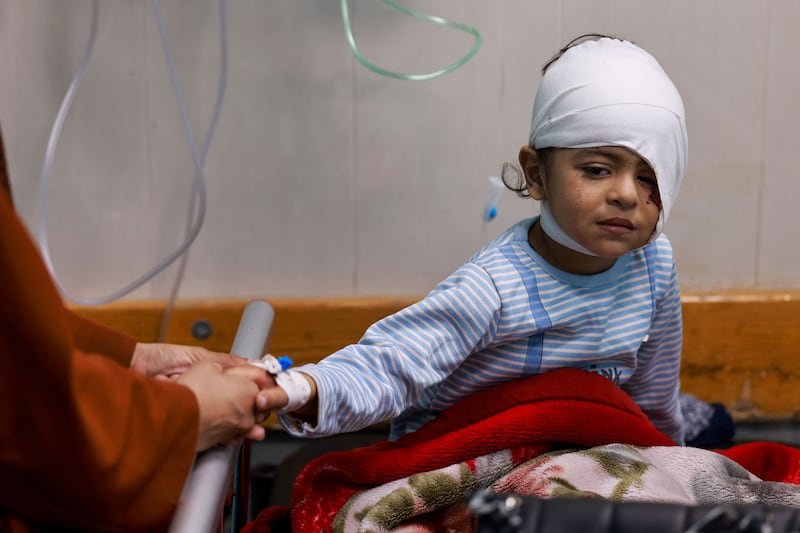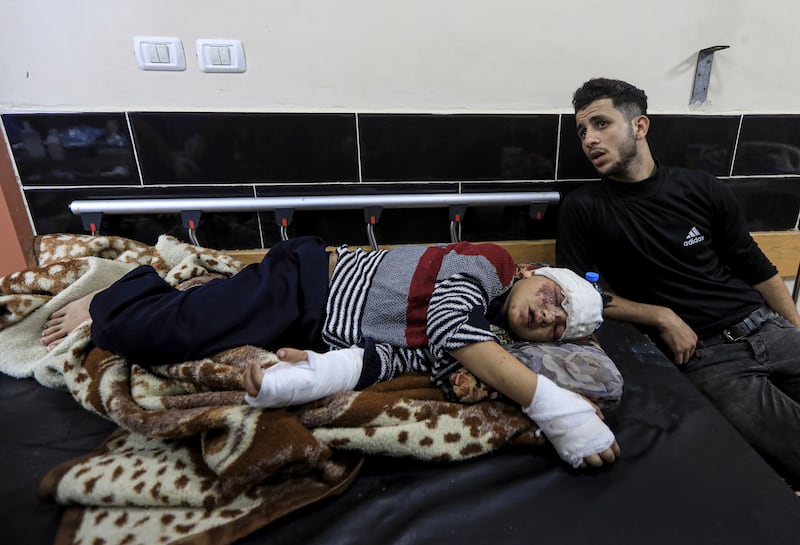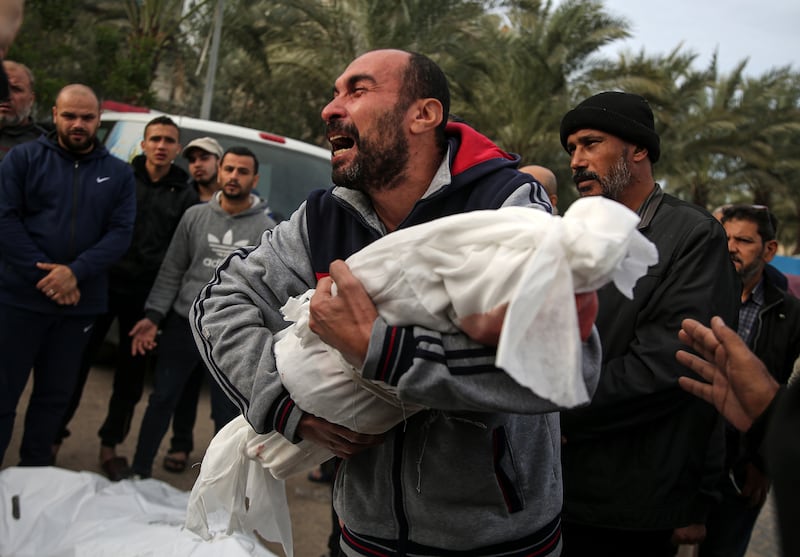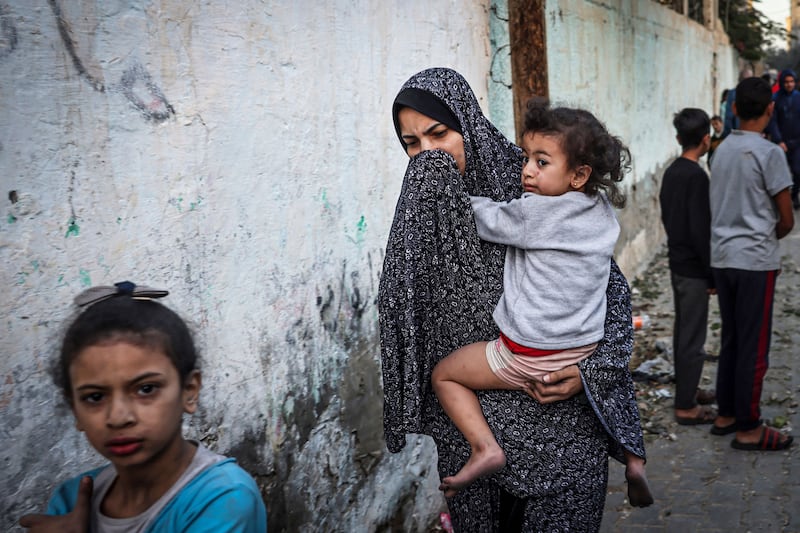When Donia Abu Mohsen (13) briefly regained consciousness after an Israeli missile strike in south Gaza, she was covered in broken masonry and lying on a rooftop where the blast had flung her. Her father was bleeding next to her, and her younger sister, Dania (9) was crying.
Donia cannot remember what happened next after the attack last month, but she woke in hospital to find her right leg had been amputated.
“I noticed the leg injuries on the roof, but I didn’t feel anything then,” Donia said from her bed at Nasser Hospital in Khan Younis. “When I saw it here, I broke down in tears.”
Relatives delivered yet more awful news: both her parents had been killed along with another sister, Dalia (6) and baby brother Mohamed. “I felt my heart had stopped” she said. “My parents were very loving. I think of them every day and I pray the war will end.”
READ MORE
Like Donia, thousands of Palestinian children in Gaza have been injured or have lost their parents, or both, in weeks of relentless Israeli bombardment of the densely populated strip. The war has turned the besieged enclave into a “graveyard for children”, António Guterres, the UN secretary general, has said.

Until the temporary truce that began last Friday, children had been killed, maimed and orphaned each day since Israel launched its offensive against Gaza. Many of those who survived have been left with disabilities and traumas that will stay with them throughout their lives, doctors say. Children make up almost half of Gaza’s 2.3 million people.
“Children are living through a long horror film under constant bombardment,” said Ayed Abu Eqtaish, programme director at Defense for Children International-Palestine, a civil society group. “On top of the fear, everything they should receive as a right, like clean water and bread, is difficult to get.”
[ Fear, hushed voices and days without food: life as a Hamas hostageOpens in new window ]
Israel launched its war in Gaza in response to the cross-border rampage on October 7th by Hamas militants who killed 1,200 people and abducted 240 others, including children, according to the Israeli government. Israeli leaders say their aim is to “root out” the militant group, which they accuse of hiding weapons and military infrastructure among civilians used as “human shields”.
Some 6,000 of the 14,800 Palestinians killed by Israeli strikes since October 7th are children, according to the Hamas-run Gaza health ministry. At least another 9,000 have been injured, many suffering horrific burns and wounds requiring amputations. About 3,500 children are reported missing, believed to be crushed under the rubble of collapsed buildings.

Aid workers say doctors in Gaza have coined the initialism WCNSF – Wounded Child No Surviving Family – for those who arrive from scenes of explosions where their families have been wiped out. “This is unique to the Gaza Strip where you now have an avalanche of human suffering and attacks killing several generations of the same family,” said Hiba Tibi, West Bank and Gaza country director of Care International UK.
Wounded children have joined a flood of injured Palestinian adults who have overwhelmed the few hospitals still functioning in Gaza. Doctors have struggled to offer treatment with depleted supplies and almost no electricity. Sometimes they have had to carry out painful procedures on children and adults without anaesthesia because there are no drugs.
Nahhed Abu Taima, director of Nasser Hospital, said children often arrived in a critical condition. “They’d lost limbs, or have severe internal injuries which force us to operate to remove organs like the spleen or parts of the liver and intestines.”
Taima added that injured children also suffered from severe psychological shock manifested in symptoms such as incontinence and the inability to sleep. “This is caused by experiencing fear and terror, the loss of family members or even just witnessing cruel and painful scenes,” he said. “The traumas will stay with them always if they are not treated, but right now we do not have the means to provide this.”

At the hospital, two-year-old Abboud, his arms and legs covered in bandages, cried as his mother, Fidaa Abu Mansour, tried to comfort him. The boy suffered burns on his limbs and chest from an Israeli strike on his home last month. His parents managed to save him and his sister, but his grandmother and aunt later died of their injuries.
“Abboud cries all the time, and when he sees a doctor or anyone dressed in white he screams,” said Abu Mansour, who has also been caring for the three sons of a cousin who was killed with her infant just hours after giving birth.
Six-year-old, Amir, the youngest of the three, was still in shock and had to go back to wearing nappies, said Abu Mansour. “It makes him cry,” she said. “He witnessed the killing of his mother and baby brother. He didn’t speak for days and now he’s withdrawn and doesn’t interact.”
Children are also hungry and have little access to clean drinking water, aid agencies say, because Israel has severely restricted the entry of humanitarian supplies including food and the fuel needed for water treatment plants. This has eased somewhat since the start of the truce because more supplies have been allowed in.
Most bakeries have closed and there is little food to buy. Before the truce, 70 per cent of people in Gaza lacked access to clean water, according to UN organisations. More than 1.7 million Gazans have been displaced from their homes and live in overcrowded shelters or private homes in unhygienic conditions, increasing the spread of respiratory illnesses and diarrhoea, the UN has said.

Infants have been affected in unexpected ways. Care International’s Tibi said fear and stress had reduced the milk of breastfeeding mothers, who now have to buy formula and mix it with dirty water. “You can imagine the impact on babies,” she said. “In addition, formula isn’t easily available so they use less of it with more water so the baby feels full.”
The UN and humanitarian organisations have repeatedly called for a lasting ceasefire but, so far, Israel, backed by the US, has insisted that the war has to fulfil its aim of destroying Hamas. Israel insists it is seeking to minimise civilian casualties but the UN’s Guterres has described the war as “collective punishment” of the Palestinians.
Binyamin Netanyahu, Israel’s prime minister, has said the war will resume after the temporary truce, which is intended to allow the return of hostages held by Hamas.
As children in Gaza await an end to the nightmare, many are contemplating a future of loss and disability very different from the dreams they once had. But some are determined to salvage something from the wreckage of a war they had no hand in starting.
Mohamed Nawfal (13) lost a leg and two fingers from his right hand in an Israeli strike on November 4th. “I was very sad when I heard my leg was amputated, but I thought maybe God will compensate me with something better. He knows I’m strong and can withstand it,” he said.
Mohamed voiced disappointment that he may no longer be able to play football and would have to content himself with supporting Real Madrid, his favourite team.
Still, he added: “I won’t give in. I have been told I can have a prosthetic leg and there are championships for players like me.” – Copyright The Financial Times Limited 2023
















